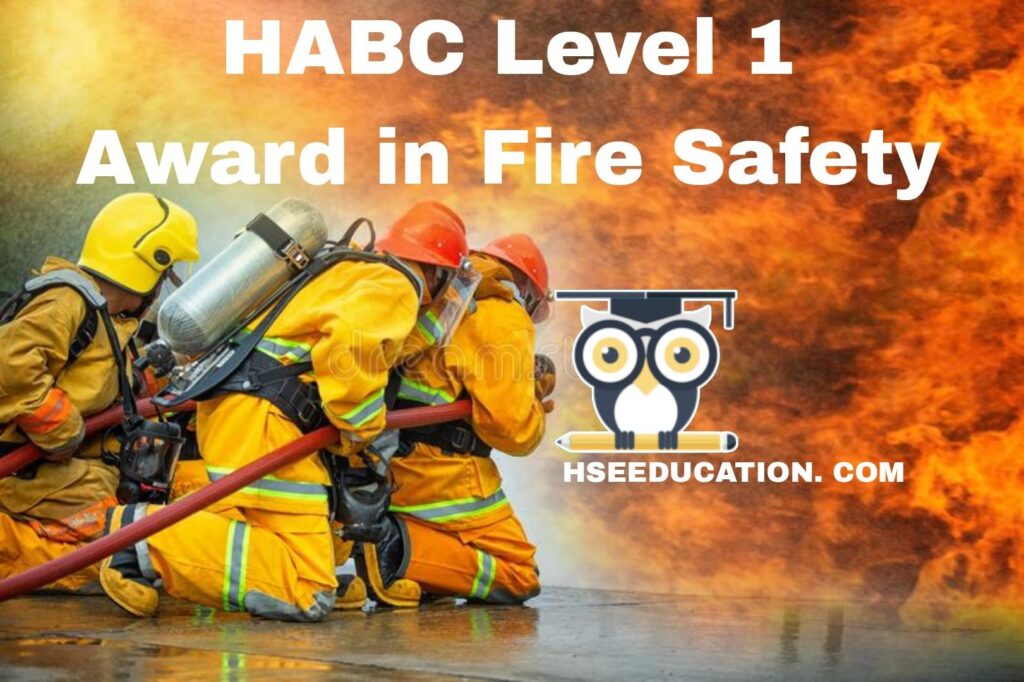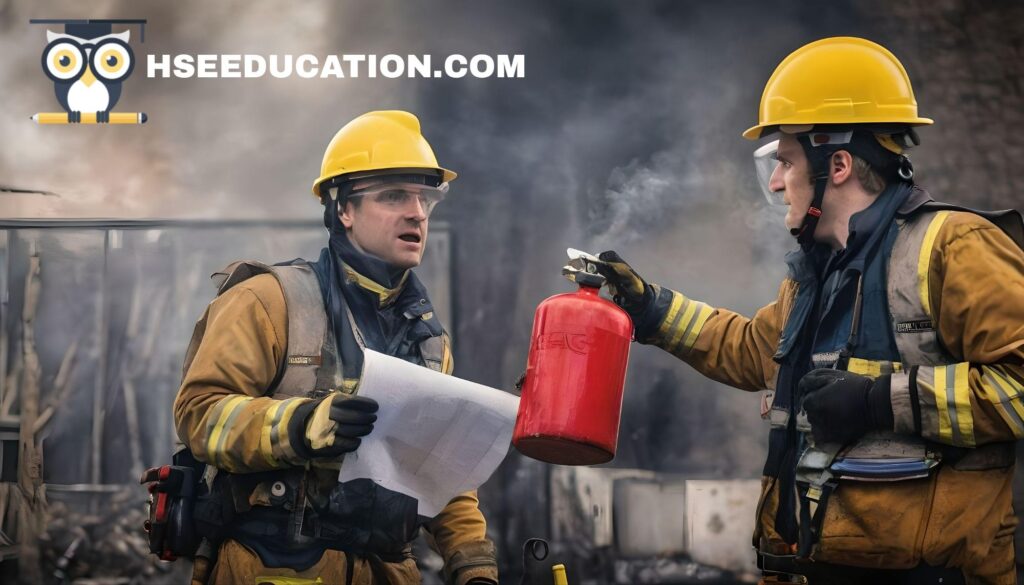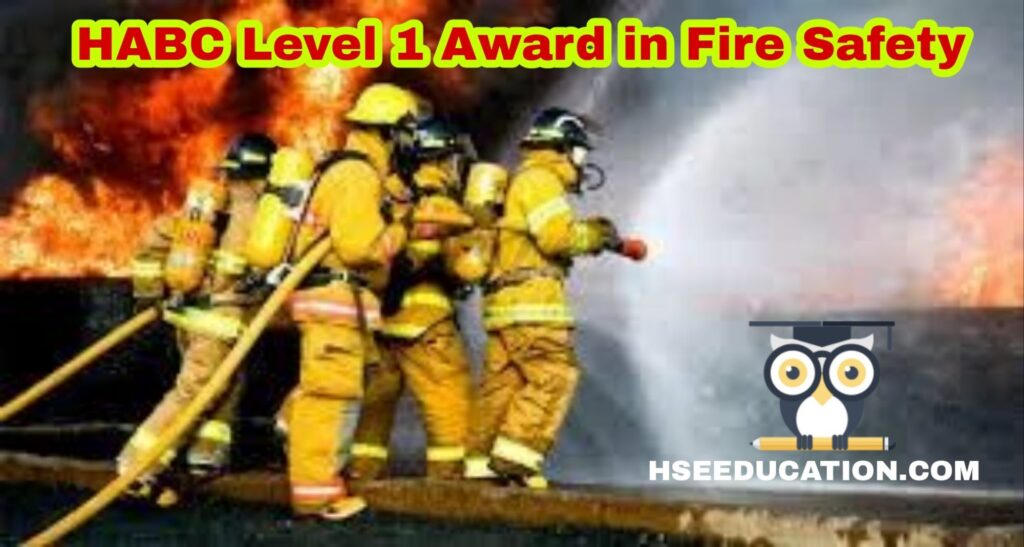HABC Level 1 Award in Fire Safety Awareness Courses Information

The HABC Level 1 Award in Fire Safety Awareness is designed to provide a basic understanding of fire safety in the workplace. This qualification is suitable for all employees and serves as an introduction to fire safety principles and practices. Here are the details of the course:
Course Content
- Understanding Fire Safety:
- The importance of fire safety.
- Fire-related legislation and responsibilities.
- Common causes of fire in the workplace.
- Fire Prevention:
- Identifying fire hazards.
- Risk assessment and control measures.
- Safe practices to prevent fire.
- Fire Protection:
- Types of fire extinguishers and their uses.
- Basic fire-fighting techniques.
- Fire detection and warning systems.
- Emergency Procedures:
- Evacuation procedures.
- Roles and responsibilities during an emergency.
- How to respond to a fire alarm.
Course Delivery
- Duration: Typically, the course is delivered in half a day (approximately 4 hours).
- Format: The course can be delivered in a classroom setting or through online learning platforms.
- Assessment: The course is assessed through a multiple-choice exam, usually consisting of 15 questions, with a requirement to answer at least 10 questions correctly to pass.
Who Should Attend?
- Employees at all levels within an organization.
- Particularly useful for new starters.
- Ideal for those looking to gain a basic understanding of fire safety in the workplace.
Certification
- Upon successful completion of the course and assessment, participants will receive a certificate from Highfield Awarding Body for Compliance (HABC).
Benefits of the Course
- Enhances fire safety awareness among employees.
- Helps in compliance with fire safety legislation.
- Reduces the risk of fire-related incidents in the workplace.
- Empowers employees to respond effectively in the event of a fire.
If you have specific questions or need more detailed information about the course, feel free to ask.

Detailed Course Content
1. Understanding Fire Safety
- The Fire Triangle: Explanation of the three elements (heat, fuel, and oxygen) necessary for a fire to start and continue burning.
- Classes of Fire: Different types of fires (Class A, B, C, D, and F) and examples of materials that can cause these fires.
- Legislation and Responsibilities: Overview of relevant fire safety legislation (e.g., Regulatory Reform (Fire Safety) Order 2005 in the UK) and the responsibilities of employers and employees.
2. Fire Prevention
- Identifying Fire Hazards: Spotting potential fire hazards in the workplace, such as faulty electrical equipment, flammable materials, and poor housekeeping.
- Risk Assessment: How to conduct a basic fire risk assessment to identify and mitigate fire risks.
- Control Measures: Practical steps to reduce fire risks, including safe storage of flammable materials, regular maintenance of electrical equipment, and implementing good housekeeping practices.
3. Fire Protection
- Fire Extinguishers: Types of fire extinguishers (water, foam, CO2, dry powder, and wet chemical) and the types of fires they are suitable for.
- Basic Fire-Fighting Techniques: How to use a fire extinguisher, fire blanket, and other basic fire-fighting equipment.
- Fire Detection and Warning Systems: Types of fire detection systems (smoke detectors, heat detectors) and the importance of regular testing and maintenance.
4. Emergency Procedures
- Evacuation Procedures: The importance of having a clear and practiced evacuation plan, including designated escape routes and assembly points.
- Roles and Responsibilities: The roles of fire wardens and marshals, and the importance of clear communication during an emergency.
- Responding to a Fire Alarm: Steps to take when a fire alarm sounds, including closing doors behind you, not using elevators, and assisting others if safe to do so.
Course Delivery and Format
- Duration: The course typically lasts around 4 hours, making it easy to fit into a half-day training session.
- Classroom Setting: Delivered in person by a qualified instructor, allowing for interactive learning and practical demonstrations.
- Online Learning: Flexible online modules for remote learning, often supplemented with interactive elements and virtual assessments.
Assessment Details
- Multiple-Choice Exam: At the end of the course, participants take a multiple-choice exam with around 15 questions.
- Pass Mark: A minimum of 10 correct answers out of 15 is required to pass the exam.
- Certificate: Successful participants receive a certificate from Highfield Awarding Body for Compliance (HABC), valid for three years.
Who Should Attend?
- All Employees: Suitable for employees at all levels, including office workers, factory workers, and those in public service roles.
- New Starters: Essential for new employees as part of their induction training.
- High-Risk Areas: Highly recommended for employees working in environments with higher fire risks, such as kitchens, workshops, and chemical storage areas.
Benefits of the Course
- Compliance: Helps organizations comply with fire safety regulations and legal requirements.
- Safety Culture: Promotes a culture of safety and awareness within the organization.
- Risk Reduction: Reduces the likelihood of fire incidents by equipping employees with the knowledge to prevent and respond to fires.
- Emergency Preparedness: Ensures that employees know how to act quickly and effectively in the event of a fire, potentially saving lives and minimizing damage.
Additional Information
- Course Materials: Participants usually receive course materials, including a handbook or manual, to support their learning and serve as a future reference.
- Continued Professional Development (CPD): The course may count towards CPD hours for professionals in certain sectors.

Detailed Course Modules
Understanding Fire Safety
The Fire Triangle:
- Heat Sources: Common heat sources in the workplace (e.g., electrical equipment, heating systems, open flames).
- Fuel Types: Materials that can act as fuel (e.g., paper, wood, chemicals, textiles).
- Oxygen: The role of oxygen in fire and how controlling airflow can impact fire growth.
Classes of Fire:
- Class A: Fires involving solid materials such as wood, paper, or textiles.
- Class B: Fires involving liquids or liquefiable solids such as petrol, oils, or paints.
- Class C: Fires involving gases.
- Class D: Fires involving metals.
- Class F: Fires involving cooking oils and fats.
Legislation and Responsibilities:
- Employer Responsibilities: Legal obligations for fire safety (risk assessments, providing training, maintaining fire safety equipment).
- Employee Responsibilities: Following fire safety protocols, reporting hazards, participating in fire drills.
Fire Prevention
Identifying Fire Hazards:
- Electrical Hazards: Overloaded sockets, damaged wiring, malfunctioning equipment.
- Flammable Materials: Proper storage and handling of flammable substances.
- Housekeeping: Importance of keeping work areas tidy and free from unnecessary clutter.
Risk Assessment:
- Steps in a Fire Risk Assessment: Identifying hazards, evaluating risks, implementing controls, and reviewing assessments regularly.
- Documenting Findings: Keeping records of assessments and actions taken.
Control Measures:
- Engineering Controls: Fire alarms, sprinklers, fire doors, and other built-in safety features.
- Administrative Controls: Policies, procedures, training, and emergency plans.
- Personal Controls: Individual actions and responsibilities, such as safe practices and immediate reporting of hazards.
Fire Protection
Fire Extinguishers:
- Water Extinguishers: Suitable for Class A fires.
- Foam Extinguishers: Suitable for Class A and B fires.
- CO2 Extinguishers: Suitable for electrical fires and Class B fires.
- Dry Powder Extinguishers: Suitable for Class A, B, C fires.
- Wet Chemical Extinguishers: Suitable for Class F fires, particularly in kitchens.
Basic Fire-Fighting Techniques:
- PASS Technique: Pull the pin, Aim at the base of the fire, Squeeze the handle, Sweep from side to side.
- Fire Blankets: How to use a fire blanket on small fires and on a person whose clothing is on fire.
Fire Detection and Warning Systems:
- Smoke Detectors: Ionization and photoelectric smoke detectors.
- Heat Detectors: Fixed temperature and rate-of-rise heat detectors.
- Manual Call Points: How and when to activate manual call points.
Emergency Procedures
Evacuation Procedures:
- Creating an Evacuation Plan: Routes, exits, assembly points.
- Conducting Fire Drills: Importance of regular drills and reviewing their effectiveness.
- Special Considerations: Assisting individuals with disabilities or other special needs.
Roles and Responsibilities:
- Fire Wardens: Their role in fire prevention, conducting risk assessments, leading evacuations, and using fire-fighting equipment.
- Emergency Coordinators: Overall responsibility during an emergency, coordinating with emergency services.
Responding to a Fire Alarm:
- Immediate Actions: Evacuate calmly, do not use lifts, close doors behind you, head to assembly points.
- Accountability: Ensuring everyone is accounted for at assembly points, reporting missing persons to emergency services.
Additional Aspects
Interactive Elements:
- Scenario-Based Learning: Realistic scenarios to practice identifying hazards and making decisions.
- Hands-On Practice: Using fire extinguishers, fire blankets, and other equipment in a controlled environment.
Continued Learning and Refresher Training:
- Annual Refresher Courses: Keeping knowledge up-to-date with annual refresher training.
- Advanced Courses: Progressing to higher levels of fire safety training, such as the HABC Level 2 Award in Fire Safety.
Customization for Specific Industries:
- Tailored Training: Customizing course content to address specific hazards and regulations relevant to different industries (e.g., healthcare, manufacturing, hospitality).

Practical Information
Course Providers:
- Accredited Providers: List of approved training providers can be found on the Highfield Qualifications website.
- In-House Training: Many organizations offer in-house training to their employees, conducted by certified trainers.
Pricing and Enrollment:
- Course Fees: Vary depending on the provider and delivery method. Group discounts may be available for in-house sessions.
- Enrollment Process: Typically involves registering with a course provider, either online or via phone.
Post-Course Support:
- Resources: Access to online resources, handbooks, and support materials after course completion.
- Networking: Opportunities to join fire safety forums and networks for ongoing learning and support.
This comprehensive overview should provide a clear understanding of what the HABC Level 1 Award in Fire Safety Awareness course entails. If you need specific information on course dates, locations, or particular providers, please let me know.
Certainly! Let’s delve into more details and expand on certain aspects of the HABC Level 1 Award in Fire Safety Awareness.
In-Depth Course Content
Understanding Fire Safety
The Fire Triangle:
- Detailed Explanation:
- Heat: Sources such as friction, electrical energy, chemical reactions.
- Fuel: Classification of fuels and how they contribute to the fire (solid, liquid, gaseous).
- Oxygen: Understanding how oxygen concentration affects fire behavior and methods to control oxygen levels to prevent fires.
Classes of Fire:
- Class A Fires: Combustible materials such as wood, paper, textiles.
- Class B Fires: Flammable liquids like gasoline, oils, paints.
- Class C Fires: Flammable gases such as propane, butane.
- Class D Fires: Combustible metals like magnesium, aluminum.
- Class F Fires: Cooking fats and oils, specifically in kitchen settings.
Legislation and Responsibilities:
- Regulatory Reform (Fire Safety) Order 2005 (UK):
- Employers’ Duties: Conducting fire risk assessments, providing fire safety training, ensuring fire safety measures are in place.
- Employees’ Duties: Following fire safety procedures, participating in drills, reporting hazards.
Fire Prevention
Identifying Fire Hazards:
- Common Workplace Hazards:
- Electrical Hazards: Worn-out cables, improper use of extension cords.
- Flammable Substances: Correct storage and labeling.
- Machinery and Equipment: Regular maintenance and inspection.
Risk Assessment:
- Five Steps to Fire Risk Assessment:
- Identify fire hazards.
- Identify people at risk.
- Evaluate, remove, reduce, and protect from risk.
- Record, plan, inform, instruct, and train.
- Review assessment regularly and revise if necessary.
Control Measures:
- Engineering Controls: Fire doors, fire-resistant materials, automatic sprinkler systems.
- Administrative Controls: Clear evacuation procedures, regular fire drills, visible signage.
- Personal Protective Measures: Use of appropriate PPE (Personal Protective Equipment) if required.
Fire Protection
Fire Extinguishers:
- Types and Their Uses:
- Water Extinguishers: For Class A fires.
- Foam Extinguishers: For Class A and B fires.
- CO2 Extinguishers: For electrical fires and Class B fires.
- Dry Powder Extinguishers: Versatile, suitable for Class A, B, C fires.
- Wet Chemical Extinguishers: Specifically for Class F fires, such as kitchen fires.
Basic Fire-Fighting Techniques:
- PASS Technique: Pull the pin, Aim at the base, Squeeze the handle, Sweep from side to side.
- Fire Blankets: How to properly use a fire blanket for small fires or on individuals.
Fire Detection and Warning Systems:
- Types of Detectors:
- Smoke Detectors: Ionization and photoelectric types.
- Heat Detectors: Fixed temperature and rate-of-rise detectors.
- Manual Call Points: How to activate and their importance.
Emergency Procedures
Evacuation Procedures:
- Creating an Effective Plan:
- Evacuation Routes: Clear, unobstructed paths.
- Assembly Points: Designated safe areas for gathering.
- Accountability: Procedures to ensure everyone is accounted for.
Roles and Responsibilities:
- Fire Wardens and Marshals:
- Duties: Conducting checks, leading evacuations, ensuring areas are clear.
- Training: Regular training and refresher courses.
Responding to a Fire Alarm:
- Immediate Actions:
- Evacuate: Follow designated routes.
- Do Not Use Lifts: Importance of using stairs.
- Close Doors: Helps contain the fire.
- Assembly Points: Importance of reaching and remaining at assembly points.
Practical Exercises and Interactive Elements
Scenario-Based Learning:
- Real-Life Scenarios: Practicing responses to simulated fire situations.
- Hazard Identification Exercises: Spotting and addressing potential fire hazards in a controlled environment.
Hands-On Practice:
- Using Fire Extinguishers: Participants practice using different types of extinguishers.
- Fire Blanket Use: Demonstrations and practice in using fire blankets effectively.
Continued Learning and Professional Development
Annual Refresher Courses:
- Importance: Keeping skills and knowledge up-to-date.
- Content: Reviewing key concepts, updates on legislation, practical exercises.
Advanced Courses:
- HABC Level 2 Award in Fire Safety:
- Content: More in-depth coverage of fire safety management, including detailed risk assessments and emergency planning.
- Target Audience: Supervisors, managers, and those responsible for fire safety in their workplace.
Customization and Industry-Specific Training
Tailored Training Programs:
- Industry-Specific Content: Addressing unique fire risks and regulations in different sectors.
- Healthcare: Special considerations for hospitals and care homes.
- Manufacturing: Managing fire risks in industrial settings.
- Hospitality: Fire safety in hotels, restaurants, and entertainment venues.
Practical Information and Logistics
Course Providers:
- Accredited Providers: Ensuring high-quality training from approved organizations.
- In-House Training Options: Flexible training delivered on-site for convenience.
Pricing and Enrollment:
- Course Fees: Typically varies by provider, with potential discounts for group bookings.
- Enrollment Process: Registration through course provider’s website or via phone.
Post-Course Support:
- Resources: Access to additional reading materials, online resources, and support.
- Networking Opportunities: Joining fire safety forums, groups, and networks for ongoing development and support.

Conclusion
The HABC Level 1 Award in Fire Safety Awareness provides essential knowledge and skills to help employees recognize fire hazards, understand the principles of fire safety, and know how to respond in the event of a fire. It is a vital component of workplace safety training, promoting a safer work environment for everyone.
If you need more detailed information or have specific questions about the course, providers, or logistics, please let me know.
“Enhance Workplace Safety with the HABC Level 1 Award in Fire Safety Awareness: Comprehensive Training for All Employees”
- Fire Safety
- Workplace Safety
- Employee Training
- Fire Prevention
- Emergency Preparedness
- HABC Certification
- Health and Safety
- Risk Assessment
- Fire Extinguishers
- Fire Warden Training
- Fire Safety Training for Employees
- Comprehensive Fire Safety Awareness Course
- HABC Level 1 Award in Fire Safety Awareness Certification
- Workplace Fire Prevention and Control
- Emergency Evacuation Procedures Training
- Fire Risk Assessment and Management
- Health and Safety Compliance in the Workplace
- Understanding Fire Extinguisher Types and Uses
- Fire Warden and Fire Marshal Training
- Promoting a Culture of Safety in the Workplace

